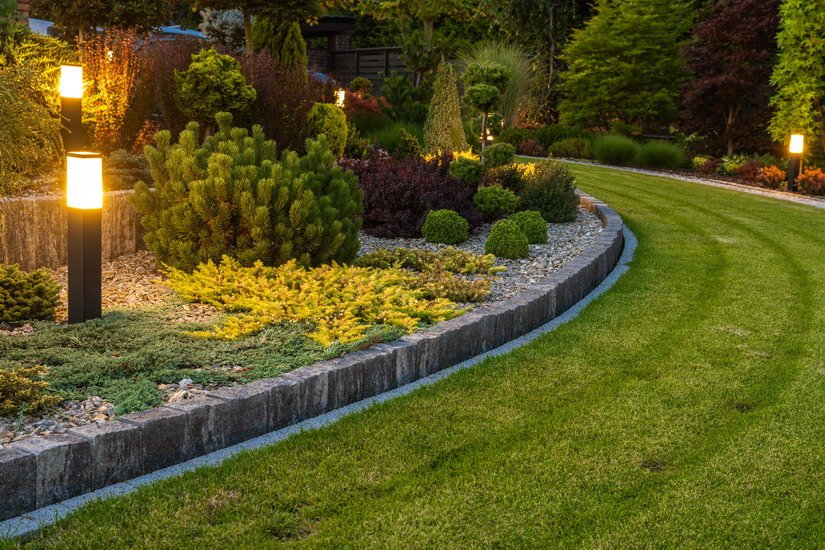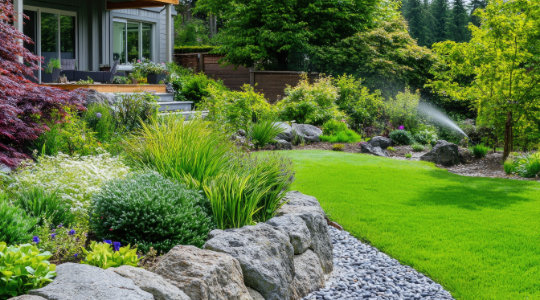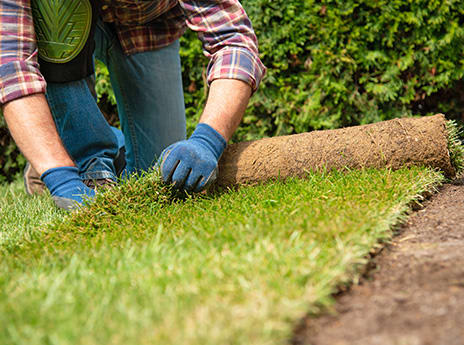Understanding the Comprehensive Scope of Works in Specialist Landscaping Services
The comprehensive extent of expert landscaping services incorporates a variety of fundamental components - landscaping services. It consists of landscape layout principles, plant choice, and hardscaping functions. Additionally, it resolves watering systems and maintenance approaches. Each aspect plays a critical role in creating practical and aesthetically pleasing outside spaces. Recognizing just how these parts collaborate can reveal much regarding the art and science of landscaping. The journey right into this elaborate area is simply starting.
Landscape Style Principles
Effective landscape layout concepts are essential for creating harmonious outdoor rooms that enhance both visual charm and performance (Learn More). These concepts guide the plan of elements within the landscape, ensuring a natural visual experience. Secret parts include balance, which disperses visual weight equally; proportion, which connects the dimension of numerous components per various other and the space; and unity, which creates a sense of wholeness through consistent styles and products

Plant Option and Setup
In the domain of specialist landscaping, plant choice and installation play an essential role in achieving a prospering garden. Emphasizing native plant benefits, seasonal considerations, and the particular dirt and sunlight requirements of each types assures a sustainable and aesthetically pleasing landscape. Careful planning in these locations not just boosts biodiversity yet likewise advertises lasting ecological health and wellness.
Indigenous Plant Advantages
Why should property owners consider indigenous plants for their landscape design tasks? Native plants provide countless benefits that enhance both looks and environmental sustainability. They are well-adapted to neighborhood environments, requiring much less water and upkeep contrasted to non-native types. This resilience reduces the requirement for chemical fertilizers and chemicals, advertising a healthier environment. Furthermore, native plants provide environment and food for local wild animals, consisting of pollinators, which can increase biodiversity in household areas. Their experience with neighborhood dirt and weather condition problems also causes far better development prices and longevity. By picking indigenous plants, property owners not just produce visually attractive landscapes however likewise contribute to eco-friendly conservation, making a positive influence on their neighborhood setting. Indigenous plants represent a wise option for landscape design tasks.
Seasonal Plant Considerations
Home owners who have actually embraced native plants in their landscape design can better improve their outside spaces by thinking about seasonal plant options. By integrating plants that prosper in specific periods, they can develop dynamic and aesthetically attractive landscapes throughout the year. Springtime may introduce vibrant blooms like daffodils and tulips, while summertime can display rich vegetation and colorful perennials. Autumn introduces a scheme of warm tones with asters and goldenrods, while winter can be emphasized with evergreens and decorative turfs for structure. Expert landscapers typically advise picking plants that not just enhance existing indigenous varieties but likewise supply year-round passion and support regional wildlife. This thoughtful approach to seasonal plant selection guarantees a constantly evolving and lasting yard atmosphere.
Soil and Sunlight Requirements
Effective landscaping rests on recognizing the particular dirt and sunlight demands of plants. Different species prosper under varying conditions, needing a careful evaluation of both factors throughout the option process. Dirt types, such as sandy, clay, or loamy, impact drain, vitamins and mineral schedule, and origin advancement. Additionally, pH levels can impact plant health and wellness, necessitating soil screening to establish viability. Sunshine requirements differ considerably; some plants prosper in full sun, while others prefer full or partial color. A professional landscaping company takes into consideration these components to guarantee peak development and visual charm. By aligning plant selections with the setting's particular attributes, landscapes can attain sustainability, durability, and visual consistency, eventually resulting in effective plant establishment and lasting maintenance.
Hardscaping Attributes and Construction

While landscaping commonly evokes pictures of rich plant and vivid blossoms, hardscaping attributes play a vital function in specifying outside rooms. These components, which include patio areas, sidewalks, retaining walls, and ornamental stonework, give structure and capability to gardens and lawns. Hardscaping uses products such as concrete, timber, rock, and block, enabling diverse designs that match the all-natural landscape.
The building of hardscaping functions needs cautious preparation and implementation to assure durability and visual appeal. Experts examine website conditions, water drainage, and spatial relationships to create cohesive outside atmospheres. Appropriate installation strategies are important, as they prevent issues like disintegration and changing in time.
Including hardscaping not just improves the visual passion of a property yet likewise assists in outside activities, making it a fundamental facet of complete landscaping services. Inevitably, thoughtful hardscaping adds to both the capability and appeal of exterior areas.
Watering Systems and Water Management
Effective watering systems and water monitoring are important components of professional landscape design, as they ensure that plants obtain the required hydration for suitable growth. These systems can vary from basic drip watering arrangements to innovative automated automatic sprinkler, developed to satisfy the specific demands of varied landscapes. Appropriate water monitoring not just enhances water use, minimizing waste, but additionally enhances plant health and minimizes condition risks.
Landscape design professionals assess numerous factors, including dirt kind, plant types, and neighborhood environment, to create tailored irrigation solutions. In addition, incorporating rainwater harvesting techniques can better enhance sustainability and efficiency. Normal upkeep of irrigation systems is crucial to maintain functionality and stop leakages, which can cause water loss and enhanced costs (Learn More). Ultimately, a well-designed irrigation system plays an essential function in maintaining the visual charm of exterior rooms while advertising environmental stewardship within expert landscaping practices
Grass Care and Upkeep Methods
Lawn care and upkeep methods are basic for attaining a lush, healthy backyard that boosts the general landscape. These approaches include numerous practices focused on promoting perfect growth and visual charm. Routine mowing is essential, as it urges thick, even growth while protecting against weeds from establishing. In addition, appropriate fertilizing supplies essential nutrients, with applications tailored to the particular turf type and dirt conditions.
Watering practices need to concentrate on deep, irregular watering to encourage origin advancement, while aeration boosts dirt framework and promotes vitamins and mineral absorption. Parasite and illness monitoring is also vital; determining concerns early permits reliable therapies that reduce damage.
Overseeding can rejuvenate broken or thin yards, boosting thickness and shade (landscaping). By applying these targeted lawn treatment techniques, landscape design professionals can assure that backyards stay vibrant and healthy and balanced throughout the seasons, considerably contributing to the overall appeal of the home
Seasonal Landscape Treatment and Upkeep
As the seasons modification, correct landscape care ends up being vital for keeping the wellness and beauty of outdoor spaces. Each period presents special challenges and needs. In springtime, landscape experts concentrate on trimming, growing, and feeding to motivate development. Summer demands normal watering, weed control, and bug management to secure recently established plants.

Throughout the year, seasonal landscape maintenance guarantees that outside locations stay healthy and aesthetically attractive. Professional services can provide customized maintenance strategies that adapt to the certain demands of each season, allowing homeowner to appreciate vivid landscapes year-round. In general, seasonal treatment is a crucial facet of professional landscape design that advertises durability and aesthetic worth.

Sustainable Landscape Design Practices
A growing number of homeowner are embracing lasting landscaping practices to develop environmentally friendly outside rooms. These methods focus on conserving resources, enhancing biodiversity, and reducing ecological effect. Indigenous plants are usually selected for their low tide demands and compatibility with regional communities, reducing the need for chemical fertilizers and chemicals. Rain gardens and absorptive paving are used to take care of stormwater runoff, advertising groundwater recharge and decreasing disintegration.
Furthermore, lasting landscape design incorporates organic gardening methods that prioritize soil wellness and promote natural insect control. Efficient watering systems, such as drip irrigation and rainwater harvesting, help maximize water use. Additionally, landscape designers increasingly promote for making use of recycled products, such as recovered timber and rocks, to decrease waste. By adopting these lasting practices, homeowner not only add to eco-friendly preservation however also develop visually pleasing atmospheres that can love very little maintenance.
Frequently Asked Inquiries
Just how Lengthy Does a Landscaping Task Commonly Take to Full?
Usually, a landscaping project can take anywhere from a couple of days to numerous weeks to finish, depending upon the task's intricacy, dimension, and style demands. Aspects such as weather condition and source schedule additionally influence timelines.
What Variables Impact the Cost of Landscaping Services?
Different aspects affect landscaping solution costs, consisting of job size, style intricacy, material top quality, labor costs, geographic location, and seasonal need. Each component adds distinctively to the general financial requirements of a landscape design task.
Are Landscape Design Solutions Available Year-Round?
Landscaping services are usually readily available year-round, although availability may vary based on region, seasonal weather, and certain solution offerings. Some services may be limited during extreme weather condition or off-peak seasons.
Do Landscaping Companies Offer Service Warranties on Their Work?
Numerous landscaping companies do provide warranties on their work, which can differ in size and protection. Customers get redirected here are encouraged to make inquiries about particular terms, ensuring they recognize what is guaranteed and any type of problems that apply.
Can I Design My Landscape Without Expert Aid?
Yes, individuals can design their landscapes without expert help. However, they might lack know-how in plant option, layout, and environmental factors to consider, potentially bring about less reliable layouts that can call for expensive adjustments later on.
In the domain of professional landscape design, plant selection and setup play an important function in achieving a growing yard. Homeowners who have accepted native plants in their landscaping can additionally enhance their outdoor rooms by considering seasonal plant options. Successful landscaping pivots on understanding the particular soil and sunshine needs of plants. Reliable irrigation systems and water monitoring are crucial parts of specialist landscaping, as they guarantee that plants receive the needed hydration for excellent growth. Landscape design experts assess various elements, consisting of soil kind, plant varieties, and local environment, to create tailored irrigation solutions.